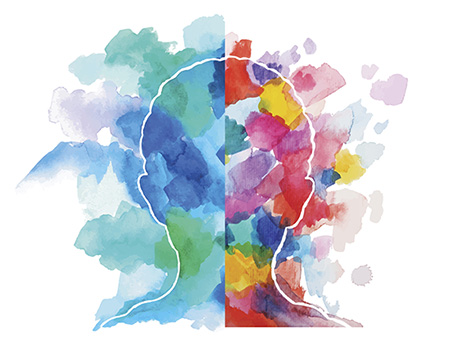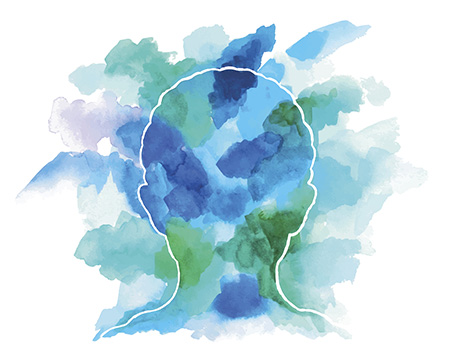 For years, UAB has been involved in the design and execution of clinical trials of a low-dose esketamine intranasal spray under the brand name of Spravato for use in patients with treatment-resistant depression (TRD). For John (*name changed to protect identity), treatment-resistant depression had significant impacts on his life.
For years, UAB has been involved in the design and execution of clinical trials of a low-dose esketamine intranasal spray under the brand name of Spravato for use in patients with treatment-resistant depression (TRD). For John (*name changed to protect identity), treatment-resistant depression had significant impacts on his life.
With a long family history of severe depression, John had tried several medications through the years to treat his depression. He was caught in an ongoing cycle of learning to tolerate new medications, treating side effects of that particular drug and then transitioning to another medication after minimal to no signs of improvement.
“I was picking the lesser of evils — I was spending time and energy treating side effects of medications that other drugs couldn’t cover,” John shared. “I’ve had my share of setbacks and in not seeing positive treatment results.”
Available medications on the market seemed to be no match for John’s treatment-resistant depression (TRD), a form of depression that does not respond to existing therapies. That was until 2017, when John was approached about enrolling in a trial at the University of Alabama at Birmingham for a new intranasal spray to treat depression — esketamine.
A new drug
In March of 2019, the Food and Drug Administration approved a low-dose esketamine intranasal spray under the brand name of SpravatoTM for use in patients with treatment-resistant depression (TRD). It is administered under physician supervision and with the accompaniment of an oral antidepressant. It is the first completely new medicine for depression in decades, and UAB has been involved in the design and execution of clinical trials of the drug for years.
Esketamine can improve depressive symptoms in some people in just hours, with effects appearing to accumulate over two weeks — a huge breakthrough in options and results for patients with TRD.
 Esketamine can improve depressive symptoms in some people in just hours, with effects appearing to accumulate over two weeks — a huge breakthrough in options and results for patients with TRD.“Medication options developed since Prozac was introduced on the market in 1988 work through similar mechanisms, contributing to the cycle of trial, error and frustration in patients like John,” explained Richard Shelton, M.D., professor in UAB’s Department of Psychiatry and Behavioral Neurobiology, who was involved in the design and execution of the esketamine trial. “The approval of intranasal esketamine opens a new phase of discovery that will help us better understand ways to provide treatment options for patients for whom traditional treatments have failed. At UAB, we are committed to furthering this discovery phase to hopefully identify other medications that can have similar impacts on TRD patients we see.”
Esketamine can improve depressive symptoms in some people in just hours, with effects appearing to accumulate over two weeks — a huge breakthrough in options and results for patients with TRD.“Medication options developed since Prozac was introduced on the market in 1988 work through similar mechanisms, contributing to the cycle of trial, error and frustration in patients like John,” explained Richard Shelton, M.D., professor in UAB’s Department of Psychiatry and Behavioral Neurobiology, who was involved in the design and execution of the esketamine trial. “The approval of intranasal esketamine opens a new phase of discovery that will help us better understand ways to provide treatment options for patients for whom traditional treatments have failed. At UAB, we are committed to furthering this discovery phase to hopefully identify other medications that can have similar impacts on TRD patients we see.”
For the last two years, UAB was one of an international research network of outpatient research centers involved in the randomized, split esketamine trial, which enrolled nearly 200 adults. One group of patients received the intranasal esketamine spray accompanied by an antidepressant that the patient had not taken before, and the other group had a placebo intranasal spray and additional antidepressant.
Many recognize the name esketamine due to its relation to ketamine, a drug commonly used in anesthetic practices but one that has also been known to be misused recreationally. However, the newly approved esketamine is different. Intranasal delivery through a lower dose enables the body to quickly metabolize the drug but more slowly release its effects, helping to treat and suppress TRD symptoms over a longer period of time.
Esketamine is remarkable in that about 70 percent of people with TRD respond, and most maintain the response with continued treatment. Many patients — including John — experienced fewer side effects, as compared to other trials and medications they have tried.
“We’ve seen some patients who have some benefit occur within 24 hours following the first dose, but the effect tends to accumulate over a two-week period,” Shelton said. “When patients respond well to the esketamine treatment, the frequency of returning for treatment helps to sustain the benefits they are experiencing.”
John quickly noticed a difference in how he managed his TRD both at home and at work.
“I felt more level, more acute,” John explained. “Esketamine has helped break the cycle of trying new things and finding my normal. I can clearly see from my experience how so many people could benefit from this treatment option.”
 “At the end of the day, I am getting back valuable, precious time in my life when my TRD is treated, and that’s what matters. I’ll do what it takes to keep that time.” Cost of commitment
“At the end of the day, I am getting back valuable, precious time in my life when my TRD is treated, and that’s what matters. I’ll do what it takes to keep that time.” Cost of commitment
As of now, the availability of intranasal esketamine is limited to specific clinics, with approval of a physician prescription being available later in 2019; UAB will be one of those sites. For Shelton, the discovery of esketamine as a treatment option means more potential for additional drug development.
“This work is continuing to further the conversation about why people are depressed and what we can do to help that,” Shelton said. “As we get closer to this fundamental understanding, UAB will continue to play a part in spearheading novel trials and research that will continue to positively impact the lives of patients living with TRD and provide more options for them.”
Patients like John who have been a part of the esketamine trial know the commitment involved to sustain the esketamine treatment regimen. TRD patients who are approved for esketamine use are administered the nasal spray under medical supervision twice a week for the first month, once per week for the second month, and every other week for the third month. Continued treatment may be required for some people beyond three months. They receive one spray per nostril at zero-, five- and 10-minute increments and cannot drive or operate machinery until the next day. Esketamine is currently not covered by insurance, but Shelton hopes it will be by the end of the year for most people.
However, in John’s case, the treatment is worth the time and financial investment in his life and future. Even more, sharing his TRD experience and what esketamine has done to positively reshape his life helps destigmatize depression.
“My wife and I look at it like this — it’s a time investment all around. The more treatments I try, our family loses time — and quality time, at that. Sure, the logistics of transportation, cost and in-office factors do exist; but we view it as a balance that’s a good win for my family,” John explained. “At the end of the day, I am getting back valuable, precious time in my life when my TRD is treated, and that’s what matters. I’ll do what it takes to keep that time.”